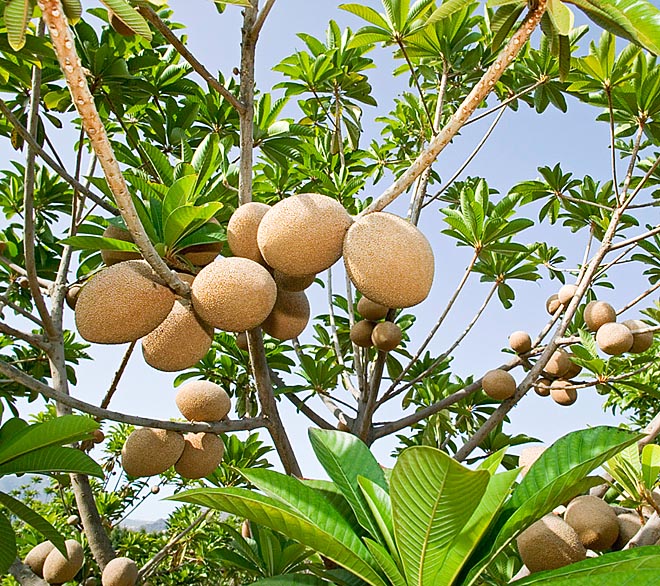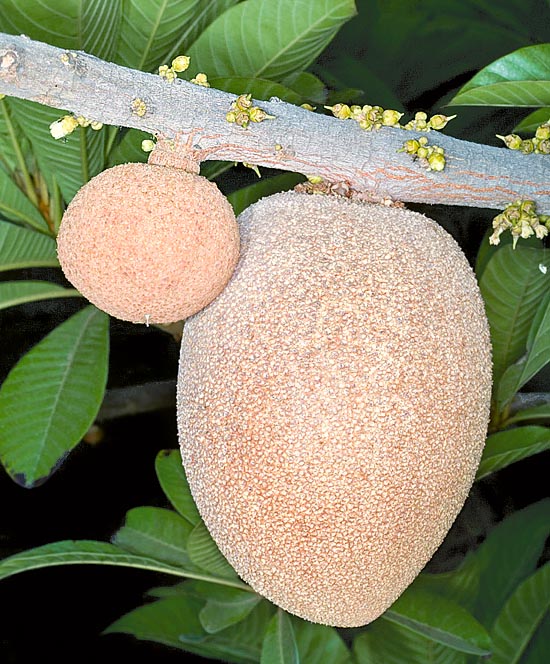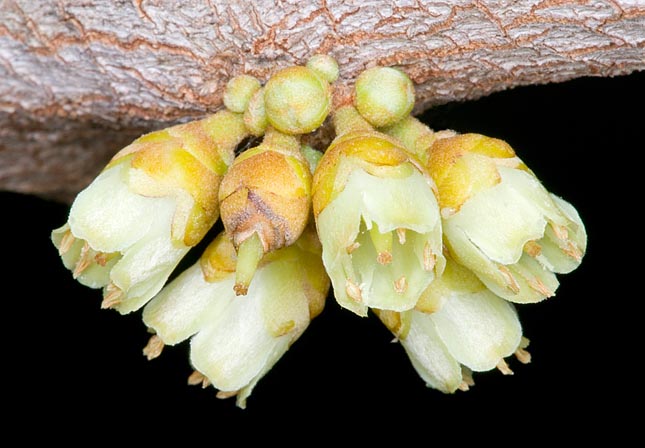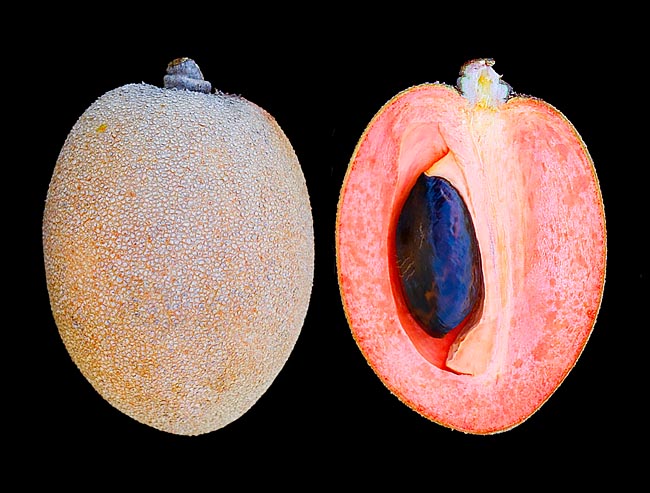Family : Sapotaceae

Text © Pietro Puccio

English translation by Mario Beltramini

Pouteria sapota is a tropical American fruit tree reaching 30 m of height © Giuseppe Mazza
The name of the genus comes from the Carib name “pourouma pouteri” of the Pouteria guianensis Aubl. (1775).
The name of the species comes from “tzapotl” which, in the Nahuatl language, generically designates a roundish fruit with morbid and sweet pulp and big seeds.
Common names: mamey sapote, mammee zapote, marmalade plum (English); grand sapotillier, grosse sapote, sapotier (French); mamey colorado, mamey de tierra, mamey rojo, mamey zapoteo, yuco, zapota grande, zapote, zapote colorado, zapote mamey (Spanish).
The Pouteria sapota (Jacq.) H. E. Moore & Stearn (1967) is a deciduous, for short time, tree, erect, up to about 30 m tall with diameter of the trunk up to 60 cm, and with milky sap.

The showy berries, even 15 cm broad and 20 long, can approach the 3 kg © Giuseppe Mazza
The white flowers, almost sessile and united in groups of 2-6 at the nodes of the terminal branches having no leaves, immediately before the part with the new foliage, are tubular, about 1 cm long, with 6-8 sepals thickly hairy spirally arranged, 4-5 petals and 5 fertile stamina and 5 sterile (staminodes).
The fruit is a berry of much variable shape depending on the variety, from spherical to fusiform, up to 20 cm long and 15 cm broad and weight from 250 g to 3 kg, with permanent calyx, brown wrinkled and coriaceous skin, and pulp, when ripe, morbid and creamy, sweet, with few fibres, of orange to salmon red colour. Usually the fruit contains on seed only, less frequently 2-4, of ellipsoidal shape and glossy brown colour; 5-10 cm long and up to about 4 cm broad.
It reproduces by seed, to be interred as soon as taken off from the fruit as it has short lasting germinative capability, vertically placed in sandy loam with the pointed part pointing downwards and leaving uncovered the upper part; the germination times vary from 4 to 10 weeks, but may be reduced by scarification.
Initially, the growth is rather slow, with production starting from 8-10 years, and generates individuals with fruits very variable in size, shape and organoleptic characteristics.
In order to reduce the times of production and reproduce a certain variety, the grafting is used, even if the percentage of success is relatively low. As rootstocks are utilized 7-9 months old seed plants and as scion terminal branches without leaves of the chosen variety of a length of 12-15 cm and a diameter of 1,5-1,8 cm; the best results are obtained with lateral grafting.

The almost sessile white flowers come out grouped from the leafless terminal branches © Giuseppe Mazza
It is a fruit known and particularly appreciated already in pre-Columbian times, but almost unknown out from the origin zones and which should deserve a greater diffusion due to its contents of sugars, proteins, minerals and vitamins, especially A and C.
It can be consumed fresh or utilized for preparing jams, drinks, jellies, ice creams and cakes; the seeds, even if rather toxic for the contents in amygdalin, a glycoside capable to free hydrocyanic acid, are used for preparing candies and in some zones of Central America they are added, grounded, to the cocoa for getting a chocolate with a characteristically bitter taste.

Dissected fruit with seed. Rich in sugars, proteins, minerals and vitamins A and C © Giuseppe Mazza
Synonyms: Sideroxylon sapota Jacq. (1760); Sideroxylum sapota Jacq. (1760); Achras zapota major Jacq. (1763); Sapota mammosa Mill. (1768); Lucuma bonplandii Kunth (1819); Bassia jussiaei Tussac (1824); Bassia jussaei Griseb. (1861); Achras mammosa Bonpl. ex Miq. (1863); Calospermum mammosum var. bonplandii (Kunth) Pierre (1890); Calospermum mammosum var. candollei Pierre (1890); Calospermum mammosum var. ovoidea Pierre (1890); Calospermum parvum Pierre (1890); Calocarpum mammosum var. bonplandii (Kunth) Pierre (1904); Calocarpum mammosum var. candollei (Pierre) Pierre (1904); Calocarpum mammosum var. ovoideum (Pierre) Pierre (1904); Calocarpum sapota (Jacq.) Merr. (1923); Calocarpum huastecanum Gilly (1944).
→ To appreciate the biodiversity within SAPOTACEAE family please click here.
